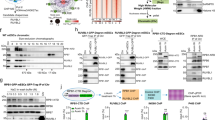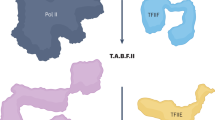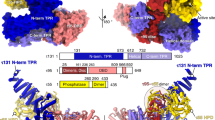Abstract
The tumor suppressor gene product BRCA1 is a component of the RNA polymerase II (pol II) holoenzyme that is involved, through binding to various regulatory proteins, in either activation or repression of transcription. Using a yeast two-hybrid screen, we have identified a human zinc-finger-containing protein NUFIP that interacts with BRCA1. The ubiquitous, stably expressed, nuclear protein NUFIP specifically stimulates activator-independent pol II transcription in vitro and in vivo. Immunodepletion of the endogenous NUFIP causes a marked decrease of pol II transcription, which is then shown to be restored by stable complex of ectopically produced NUFIP and associated factors. NUFIP not only interacts with BRCA1 but also associates with the positive elongation factor P-TEFb through interaction with the regulatory Cyclin T1 subunit. Cyclin T1 is required for BRCA1- and NUFIP-dependent synergistic activation of pol II transcription in 293 cells. Mutation of the zinc-finger domain abolishes the NUFIP-mediated transcriptional activation. We show that NUFIP is associated with preinitiation complexes, open transcription complexes, and elongation complexes. In addition, NUFIP facilitates ATP-dependent dissociation of hyperphosphorylated pol II from open transcription complexes in vitro.
This is a preview of subscription content, access via your institution
Access options
Subscribe to this journal
Receive 50 print issues and online access
$259.00 per year
only $5.18 per issue
Buy this article
- Purchase on Springer Link
- Instant access to full article PDF
Prices may be subject to local taxes which are calculated during checkout








Similar content being viewed by others
References
Abbott DW, Thompson ME, Robinson-Benion C, Tomlinson G, Jensen RA and Holt JT . (1999). J. Biol. Chem., 274, 18808–18812.
Akoulitchev S, Makela TP, Weinberg RA and Reinberg D . (1995). Nature, 377, 557–560.
Anderson SF, Schlegel BP, Nakajima T, Wolpin ES and Parvin JD . (1998). Nat. Genet., 19, 254–256.
Arias JA and Dynan WS . (1989). J. Biol. Chem., 264, 3223–3229.
Auble DT, Hansen KE, Mueller CG, Lane WS, Thorner J and Hahn S . (1994). Genes Dev., 8, 1920–1934.
Bardoni B, Schenck A and Mandel JL . (1999). Hum. Mol. Genet., 8, 2557–2566.
Bardoni B, Willemsen R, Weiler IJ, Schenck A, Severijnen LA, Hindelang C, Lalli E and Mandel JL . (2003). Exp. Cell Res., 289, 95–107.
Bochar DA, Wang L, Beniya H, Kinev A, Xue Y, Lane WS, Wang W, Kashanchi F and Shiekhattar R . (2000). Cell, 102, 257–265.
Buratowski S, Hahn S, Sharp PA and Guarente L . (1988). Nature, 334, 37–42.
Cabart P and Murphy S . (2001). J. Biol. Chem., 276, 43056–43064.
Cadena DL and Dahmus ME . (1987). J. Biol. Chem., 262, 12468–12474.
Chambers RS, Wang BQ, Burton ZF and Dahmus ME . (1995). J. Biol. Chem., 270, 14962–14969.
Chapman MS and Verma IM . (1996). Nature, 382, 678–679.
Chen Y, Farmer AA, Chen CF, Jones DC, Chen PL and Lee WH . (1996). Cancer Res., 56, 3168–3172.
Chen Y, Lee WH and Chew HK . (1999). J. Cell. Physiol., 181, 385–392.
Chiba N and Parvin JD . (2002). Cancer Res., 62, 4222–4228.
Cortez D, Wang Y, Qin J and Elledge SJ . (1999). Science, 286, 1162–1166.
Dahmus ME . (1981). J. Biol. Chem., 256, 3332–3339.
Dahmus ME . (1994). Prog. Nucleic Acid Res. Mol. Biol., 48, 143–179.
Deng CX and Brodie SG . (2000). BioEssays, 22, 728–737.
Dignam JD, Lebovitz RM and Roeder RG . (1983). Nucleic Acids Res., 11, 1475–1489.
Durfee T, Becherer K, Chen PL, Yeh SH, Yang Y, Kilburn AE, Lee WH and Elledge SJ . (1993). Genes Dev., 7, 555–569.
Dvir A, Conaway RC and Conaway JW . (1997). Proc. Natl. Acad. Sci. USA, 94, 9006–9010.
Edwards MC, Wong C and Elledge SJ . (1998). Mol. Cell. Biol., 18, 4291–4300.
Fu TJ, Peng J, Lee G, Price DH and Flores O . (1999). J. Biol. Chem., 274, 34527–34530.
Fujinaga K, Taube R, Wimmer J, Cujec TP and Peterlin BM . (1999). Proc. Natl. Acad. Sci. USA, 96, 1285–1290.
Gatei M, Zhou BB, Hobson K, Scott S, Young D and Khanna KK . (2001). J. Biol. Chem., 276, 17276–17280.
Haile DT and Parvin JD . (1999). J. Biol. Chem., 274, 2113–2117.
Harkin DP, Bean JM, Miklos D, Song YH, Truong VB, Englert C, Christians FC, Ellisen LW, Maheswaran S, Oliner JD and Haber DA . (1999). Cell, 97, 575–586.
Hawley DK and Roeder RG . (1985). J. Biol. Chem., 260, 8163–8172.
Hawley DK and Roeder RG . (1987). J. Biol. Chem., 262, 3452–3461.
Hoopes BC, LeBlanc JF and Hawley DK . (1992). J. Biol. Chem., 267, 11539–11547.
Hu YF, Hao ZL and Li R . (1999). Genes Dev., 13, 637–642.
Ivanov D, Kwak YT, Guo J and Gaynor RB . (2000). Mol. Cell. Biol., 20, 2970–2983.
Kaelin Jr WG, Pallas DC, DeCaprio JA, Kaye FJ and Livingston DM . (1991). Cell, 64, 521–532.
Kim JB and Sharp PA . (2001). J. Biol. Chem., 276, 12317–12323.
Kleiman FE and Manley JL . (2001). Cell, 104, 743–753.
Krum SA, Miranda GA, Lin C and Lane TF . (2003). J. Biol. Chem., 278, 52012–52020.
Kugel JF and Goodrich JA . (1998). Proc. Natl. Acad. Sci. USA, 95, 9232–9237.
Kugel JF and Goodrich JA . (2002). Mol. Cell. Biol., 22, 762–773.
Laybourn PJ and Dahmus ME . (1990). J. Biol. Chem., 265, 13165–13173.
Li S, Chen PL, Subramanian T, Chinnadurai G, Tomlinson G, Osborne CK, Sharp ZD and Lee WH . (1999). J. Biol. Chem., 274, 11334–11338.
Lu H, Flores O, Weinmann R and Reinberg D . (1991). Proc. Natl. Acad. Sci. USA, 88, 10004–10008.
Marshall NF, Peng J, Xie Z and Price DH . (1996). J. Biol. Chem., 271, 27176–27183.
Marshall NF and Price DH . (1992). Mol. Cell. Biol., 12, 2078–2090.
Marshall NF and Price DH . (1995). J. Biol. Chem., 270, 12335–12338.
Monteiro AN . (2000). Trends Biochem. Sci., 25, 469–474.
Monteiro AN, August A and Hanafusa H . (1996). Proc. Natl. Acad. Sci. USA, 93, 13595–13599.
Moynahan ME, Chiu JW, Koller BH and Jasin M . (1999). Mol. Cell, 4, 511–518.
Murphy S . (1997). Nucleic Acids Res., 25, 2068–2076.
Murphy S, Yoon JB, Gerster T and Roeder RG . (1992). Mol. Cell. Biol., 12, 3247–3261.
Narita T, Yamaguchi Y, Yano K, Sugimoto S, Chanarat S, Wada T, Kim D, Hasegawa J, Omori M, Inukai N, Endoh M, Yamada T and Handa H . (2003). Mol. Cell. Biol., 23, 1863–1873.
Ouchi T, Monteiro AN, August A, Aaronson SA and Hanafusa H . (1998). Proc. Natl. Acad. Sci. USA, 95, 2302–2306.
Pao GM, Janknecht R, Ruffner H, Hunter T and Verma IM . (2000). Proc. Natl. Acad. Sci. USA, 97, 1020–1025.
Parvin JD . (2001). Proc. Natl. Acad. Sci. USA, 98, 5952–5954.
Parvin JD, Shykind BM, Meyers RE, Kim J and Sharp PA . (1994). J. Biol. Chem., 269, 18414–18421.
Paull TT, Cortez D, Bowers B, Elledge SJ and Gellert M . (2001). Proc. Natl. Acad. Sci. USA, 98, 6086–6091.
Peng J, Zhu Y, Milton JT and Price DH . (1998). Genes Dev., 12, 755–762.
Ping YH and Rana TM . (1999). J. Biol. Chem., 274, 7399–7404.
Price DH . (2000). Mol. Cell. Biol., 20, 2629–2634.
Rohan RM and Ketner G . (1987). J. Biol. Chem., 262, 8500–8507.
Sawadogo M and Roeder RG . (1985). Cell, 43, 165–175.
Schlegel BP, Green VJ, Ladias JA and Parvin JD . (2000). Proc. Natl. Acad. Sci. USA, 97, 3148–3153.
Scully R, Anderson SF, Chao DM, Wei W, Ye L, Young RA, Livingston DM and Parvin JD . (1997a). Proc. Natl. Acad. Sci. USA, 94, 5605–5610.
Scully R, Chen J, Plug A, Xiao Y, Weaver D, Feunteun J, Ashley T and Livingston DM . (1997b). Cell, 88, 265–275.
Shore SM, Byers SA, Maury W and Price DH . (2003). Gene, 307, 175–182.
Somasundaram K, MacLachlan TK, Burns TF, Sgagias M, Cowan KH, Weber BL and el-Deiry WS . (1999). Oncogene, 18, 6605–6614.
Spangler L, Wang X, Conaway JW, Conaway RC and Dvir A . (2001). Proc. Natl. Acad. Sci. USA, 98, 5544–5549.
Starita LM and Parvin JD . (2003). Curr. Opin. Cell Biol., 15, 345–350.
Szentirmay MN and Sawadogo M . (1994). Nucleic Acids Res., 22, 5341–5346.
Taube R, Lin X, Irwin D, Fujinaga K and Peterlin BM . (2002). Mol. Cell. Biol., 22, 321–331.
Tibbetts RS, Cortez D, Brumbaugh KM, Scully R, Livingston D, Elledge SJ and Abraham RT . (2000). Genes Dev., 14, 2989–3002.
Venkitaraman AR . (2001). J. Cell Sci., 114, 3591–3598.
Wada T, Takagi T, Yamaguchi Y, Watanabe D and Handa H . (1998). EMBO J., 17, 7395–7403.
Wei P, Garber ME, Fang SM, Fischer WH and Jones KA . (1998). Cell, 92, 451–462.
Yamaguchi Y, Takagi T, Wada T, Yano K, Furuya A, Sugimoto S, Hasegawa J and Handa H . (1999a). Cell, 97, 41–51.
Yamaguchi Y, Wada T, Watanabe D, Takagi T, Hasegawa J and Handa H . (1999b). J. Biol. Chem., 274, 8085–8092.
Yarden RI and Brody LC . (1999). Proc. Natl. Acad. Sci. USA, 96, 4983–4988.
Ye Q, Hu YF, Zhong H, Nye AC, Belmont AS and Li R . (2001). J. Cell Biol., 155, 911–921.
Zawel L, Kumar KP and Reinberg D . (1995). Genes Dev., 9, 1479–1490.
Zheng L, Annab LA, Afshari CA, Lee WH and Boyer TG . (2001). Proc. Natl. Acad. Sci. USA, 98, 9587–9592.
Zhong Q, Boyer TG, Chen PL and Lee WH . (2002a). Cancer Res., 62, 3966–3970.
Zhong Q, Chen CF, Chen PL and Lee WH . (2002b). J. Biol. Chem., 277, 28641–28647.
Zhong Q, Chen CF, Li S, Chen Y, Wang CC, Xiao J, Chen PL, Sharp ZD and Lee WH . (1999). Science, 285, 747–750.
Acknowledgements
We thank Wen-Hwa Lee in whose laboratory some of these experiments were carried out. We thank Phang-Lang Chen, Yumay Chen, and Thomas Boyer for valuable reagents and advice. We also thank Alexandre Akoulitchev for useful discussions. We thank David Price for the pcDNA3-Cyclin T1 expression vector. The constructs encoding GST-tagged Cyclin T1 and Cyclin K were kindly provided by Matija Peterlin and Stephen Elledge.
This work was supported in part by MRC Senior Fellowship G117/309 (to SM), NIH grants (to W-HL), and VA Career Developmental Award (to HKC).
Author information
Authors and Affiliations
Corresponding author
Rights and permissions
About this article
Cite this article
Čabart, P., Chew, H. & Murphy, S. BRCA1 cooperates with NUFIP and P-TEFb to activate transcription by RNA polymerase II. Oncogene 23, 5316–5329 (2004). https://doi.org/10.1038/sj.onc.1207684
Received:
Revised:
Accepted:
Published:
Issue Date:
DOI: https://doi.org/10.1038/sj.onc.1207684
Keywords
This article is cited by
-
BRCA1 functions as a novel transcriptional cofactor in HIV-1 infection
Virology Journal (2015)
-
The role of BRCA1 in transcriptional regulation and cell cycle control
Oncogene (2006)



